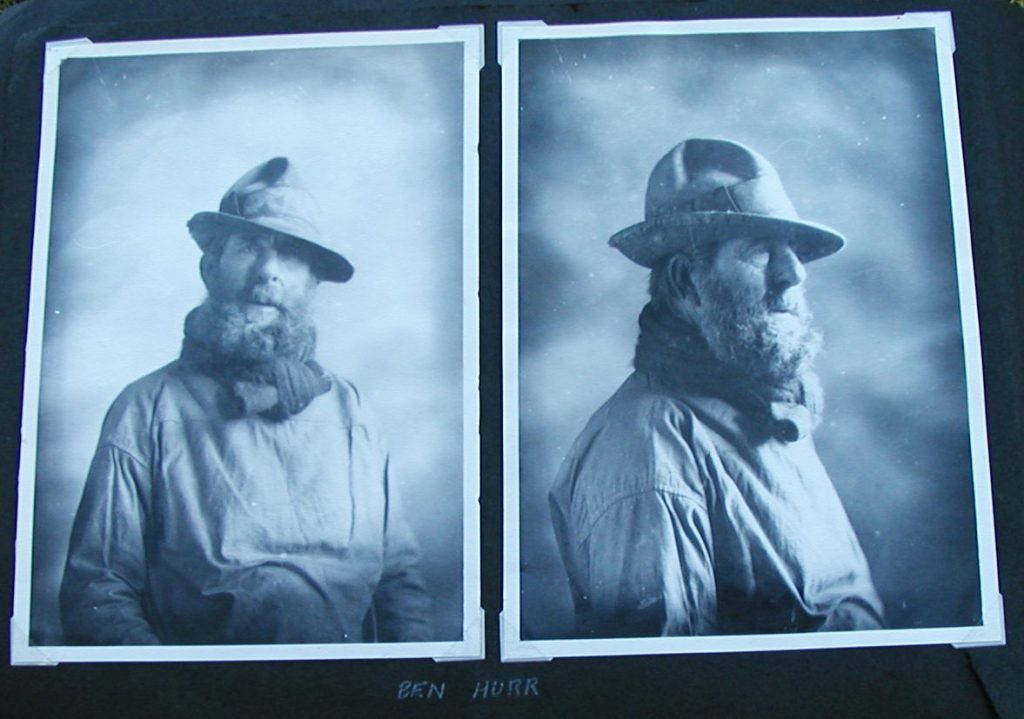
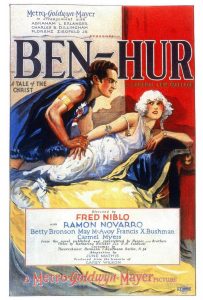 It’s just possible that this Ben Hurr (from Southwold on the Suffolk coast) knew of the famous film character Ben-Hur, as the 1880 novel was first released as a silent movie in 1925, and Southwold had its very own Electric Picture Palace from 1912. I hope the coincidence would have amused him as much as it did me when I first came across his name as a fisherman from whom folksong collectors Ralph Vaughan Williams and George Butterworth noted down songs in 1910.
It’s just possible that this Ben Hurr (from Southwold on the Suffolk coast) knew of the famous film character Ben-Hur, as the 1880 novel was first released as a silent movie in 1925, and Southwold had its very own Electric Picture Palace from 1912. I hope the coincidence would have amused him as much as it did me when I first came across his name as a fisherman from whom folksong collectors Ralph Vaughan Williams and George Butterworth noted down songs in 1910.
It turned out that the real Ben Hurr was from a large family, several of whom were known to be musical, and these initial findings have led me to investigate many aspects of traditional culture in Southwold – see the foot of this page for other related articles, including a link to the digitised manuscripts of the songs he and his brothers sang to Ralph Vaughan Williams.
On Monday 24th October 1910 Butterworth and Vaughan Williams called by a small village in east Suffolk called Shadingfield and visited Martha Keble and her son before carrying on to the small coastal town of Southwold, having probably travelled up from London by train with their bicycles. Here they noted down songs from three brothers, William, Robert and Ben Hurr. They stayed overnight, and the following day they revisited William and Robert and another singer, Charles Newby and then departed to hunt for more songs in the villages of the Norfolk Broads.
The Hurrs were all fishermen, from a large family which can be traced back for many generations in Southwold. Only a dozen or so songs were collected from them, which included several about the sea (although none about fishing) – mostly tales of shipwrecks. These songs would have been close to their hearts as two of their own brothers had been drowned at sea. Another brother, George, is also known to have sung although Vaughan Williams and Butterworth did not meet him.
The two oldest Hurr brothers, William and James, were masters of small fishing boats, including the Nancy Hugh and the Fanny and their father, also William, had owned the Caterer, the Susannah and the Vigilant at various times. Ben had the Happy Thought and later on the next generation had the Daisy and the Boy Billy. The smaller boats were mostly dandy-rigged luggers, under 20ft long, and would operate with a crew of three. Some of the drifters, which operated out of Lowestoft Harbour, had bigger crews of six or seven. It was common for families to work together and the fishermen formed beach companies to help launch and retrieve boats off the beach. These beach companies also worked together as piloting and salvage companies. The picture below of William “Dubber” Hurr shows him outside the Kilcock Cliff lookout, indicating that he belonged to that beach company.
The last Saturday in August was traditionally the day for Southwold Regatta, and in the late 1880s the Hurrs’ fishing punts Susannah and Vigilant were usually well placed. We know more about the Susannah – that she was a 19ft, 3 ton, 2-masted, lug-rigged punt built in 1869 – from a newspaper report of a far more tragic nature. The Ipswich Journal of 18th November 1893 ran a long article headed:
SOUTHWOLD PUNT SUNK. ALL HANDS DROWNED.
Two of those young men were Tom and Sam Hurr, brothers of our singers, aged just 28 and 31 respectively at the time.
They had left Southwold at 6am, fishing for cod (having put some lines down the previous night) and would normally have been back by midday. Sometime after 10am the Helois, a 29 ton sailing drifter returning to Lowestoft, through a series of mishaps and in fog, bore down “upon the unfortunate little boat, cut her completely through, and sent her three occupants struggling in the waves.”
The Helois’ crew comprised a master and seven hands. They had left Lowestoft on 13th November on a mackerel fishing voyage, and were heading back for Lowestoft on 15th, as the weather had turned. Their one lifebuoy was below decks. The Susannah, being a small open boat did not carry a lifebuoy. The news report commented “If the crew of the Susannah had oilies on or heavy boots, they could not long remain above the water …”
The enquiry found that the cause of the collision was: “the mizzen-halyard on board the Helois being used as a tiller rope, and flying off the tiller-head when the helm was put up, which caused the ship to come to, and before the ship could pay off again the collision occurred.” They also concluded that the master and crew of the Helois “made their best endeavours to save life, but, in the opinion of the Court it would have been better if the helm of the Helois had been put down immediately after the collision, as she would have been kept close to the scene of the accident.”
So the songs the brothers sang about shipwrecks would have a very real and heartbreaking meaning for them.
Ben Hurr 1860-1934
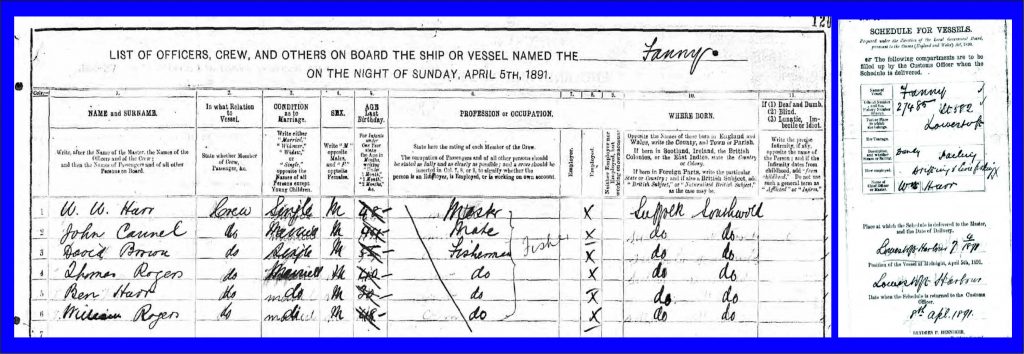 Benjamin Lowsey Hurr was the seventh child of William and Maria Hurr. Ben married Louisa Stannard in 1881 and they had one son. On the night of the 1891 census, 5th April, Ben was on board the Fanny, berthed in Lowestoft harbour. The master was his older brother William Watson Hurr and there were four other crew members.
Benjamin Lowsey Hurr was the seventh child of William and Maria Hurr. Ben married Louisa Stannard in 1881 and they had one son. On the night of the 1891 census, 5th April, Ben was on board the Fanny, berthed in Lowestoft harbour. The master was his older brother William Watson Hurr and there were four other crew members.
In the 1890s, along with brothers William and Robert, Ben was a member of the lifeboat crew – perhaps their involvement came as a direct emotional response to the loss of their two younger brothers in 1893. In the early twentieth century he and his family moved out of the small fishermen’s cottages in Victoria Street into Salisbury Road, one of the newer and more well-appointed terraces in the north end of the town.
His death was reported – rather surprisingly – in the Hartlepool Northern Daily Mail on 13th August 1934:
PEDESTRIAN VICTIMS
“Two fatal accidents occurred on Saturday within five minutes of each other, and at places three miles apart. Southwold and Frostenden, in Suffolk. Each also concerned an elderly pedestrian who received head injuries. Benjamin Hurr, fisherman (74), of Southwold, was struck by a motor-cycle ridden by Abraham Chapman, a neighbour, and died in Southwold Hospital yesterday. Edward Ife, a farm labourer (69), was struck by a bicycle ridden by a nephew.”
These fabulous portraits are probably “our” Ben Hurr, but it’s not possible to be 100% sure as there were other people with this and similar names, and the photos are not dated.
One of Ben’s songs was called The Isle of France, (an early name for Mauritius). It’s a sentimental tale of a convict, finally making his way home after six years in exile, who is shipwrecked, then rescued, and eventually receives a pardon from the Queen. Vaughan Williams often noted just the melody, if he was already familiar with the words, as in this case.
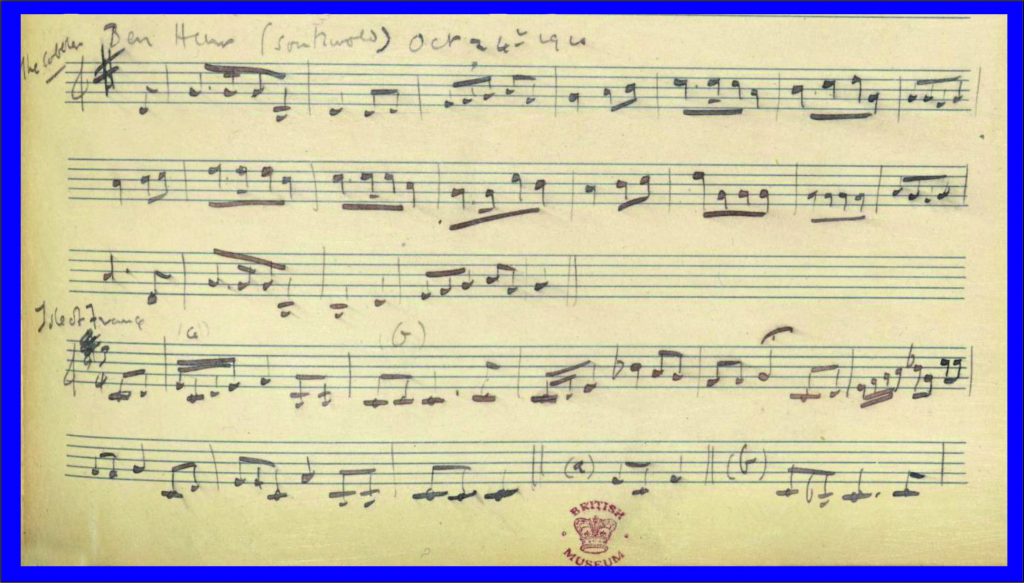
William Hurr 1843-1925
The oldest of the Hurr brothers was William Watson Hurr, known as “Dubber”.
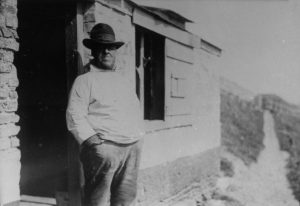
Like his younger brothers, he was both born and buried in Southwold. Census results from 1881 and 1891 of crews on board fishing boats in Lowestoft Harbour show us that he worked alongside his brothers: Ben in 1891 (mentioned above), and in 1881, with older brother George aboard the Nancy Hugh of which their middle brother, James, was master. He lived at home with his parents until he was 52, when in 1895, he married Matilda Adams (née Howard) who was working as a servant to a solicitor in Southwold. Matilda was a widow with two teenaged children from her first marriage to Joseph Adams, a private in the Royal Marines. She was a local girl, but had lived in barracks at Walmer in Kent until Joseph died after just five years of marriage, when she returned to her Suffolk home.
In the year 1899, Dubber appeared in the newspapers more than once. The first occasion, in the Eastern Evening News of 21st July being a “good news” story:
STURGEON AT SOUTHWOLD
“A large sturgeon was caught by William Watson Hurr in a trawl net and landed at Southwold on Wednesday. It measured upwards of seven feet and a half in length, and weighed some fifteen stone. It was a very fine-fed fish. Hurr being alone in his boat, and it being very dark at the time, had great difficulty getting it into the boat.”
The second reports, from October that year, reveal a much sadder situation –a family feud between William on the one side, and younger brothers Ben and Walter, supported by sisters Annie and Susannah on the other. Quite what the actual cause of the argument on 6th October was, is not clear, but in one report, William stated that he had been on bad terms with his brothers for four years. In another, Ben said he had helped to keep William for fifteen years. Blows were exchanged and William threatened to shoot Walter and Ben and the latter’s 17 year old son William Albert Benjamin. Susannah, just three years younger than William, may have tried to calm things down a bit but Annie, twenty five years William’s junior is alleged to have punched him in the face. Ben and Walter stated that they went “in bodily fear” of William. Two lady visitors staying in Southwold also gave evidence of the alleged assault, which took place by the fishermen’s sheds on the beach, a space which was shared with holidaymakers as well of course.
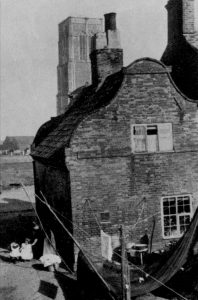 By 1901 Dubber and his family were living in what is now the Southwold Museum, which was then divided into two tiny cottages later condemned as unfit for housing. In the photograph here, you can just make out Matilda with two children, Susannah and Sam. They went on to have another daughter, Ellen in 1902, when Matilda was 47, whilst her two children from her first marriage were brought up by her brother and sister along the coast in Easton Bavents. Susannah is reputed to have been a professional singer, but I can find no evidence of this. Susannah’s husband Edgar Stockbridge worked in the brewery business and they moved away, eventually settling in Stevenage.
By 1901 Dubber and his family were living in what is now the Southwold Museum, which was then divided into two tiny cottages later condemned as unfit for housing. In the photograph here, you can just make out Matilda with two children, Susannah and Sam. They went on to have another daughter, Ellen in 1902, when Matilda was 47, whilst her two children from her first marriage were brought up by her brother and sister along the coast in Easton Bavents. Susannah is reputed to have been a professional singer, but I can find no evidence of this. Susannah’s husband Edgar Stockbridge worked in the brewery business and they moved away, eventually settling in Stevenage.
By 1912, Dubber and his family were living at Caterer House, 39 Victoria Street, where Matilda was the landlady of holiday apartments, which had been in the family previously – this line of business was shared by at least two of her sisters-in-law.
During the First World War, Dubber showed the indomitable Hurr spirit by refusing to follow war-time regulations which banned night fishing, which apparently resulted in him being shot at and sustaining an injury to his arm.
His son William Samuel Thomas (known as Sam) was one of the first who did not follow in the family tradition of fishing, and after William’s death, his boat the Vigilant passed to his nephew, Ben’s son William Albert Benjamin – the very one whom he had threatened to “wring his lugs” a quarter of a century earlier.
Vaughan Williams clearly valued William’s singing and published three of the songs he sang in the 1913 Journal of the Folk Song Society. He noted down just two verses of this song, The Loss of the London. Whether this was all that William sang, or all that Vaughan Williams was interested in, we do not know, but these words are quite different to the versions printed on broadside song sheets. The London sank off the Bay of Biscay in January 1866, so this song was written when William was a young man – it wouldn’t have been an ancient old folk song to him. [*Edit, 28.9.21: see below for a link to the story of the London.]
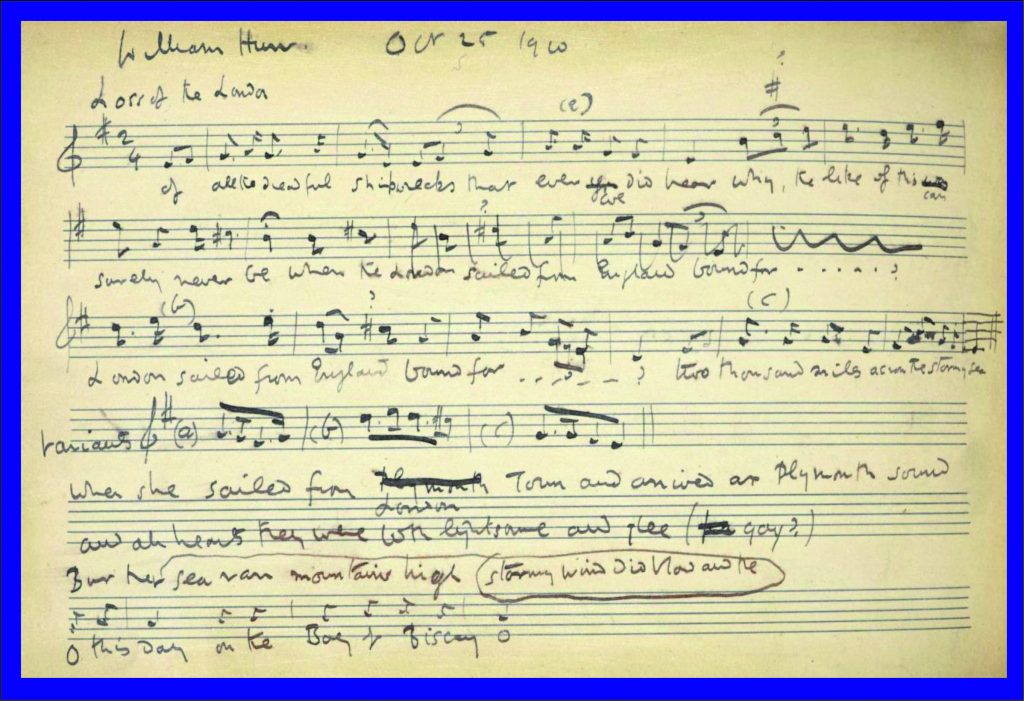
Robert Hurr 1855-1934
Robert Watson Hurr, fourth son of William and Maria, married Elizabeth Stannard in 1878 and together they had six children. In 1901 he was living in Young’s Yard, off Victoria Street and was listed in the census as “Boat owner”. There is an additional note, not easy to read – it appears to say “Nav. Shore”. There were Trinity pilots engaged to help coastal trading boats into the harbour on the River Blyth, but these are listed in the town directories of the time, and none of the Hurrs names ever appear. There’s also a blank in the column which should indicate whether the person concerned is self-employed or employed by someone else, and a big circle has been drawn there against Robert’s name, from which I infer that the census enumerator was aware of this omission and perhaps intended to go back and find out. In 1911, his occupation is given as fisherman and his status as “employed”.
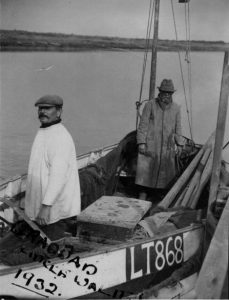 In later years Robert worked in partnership with his son Walter (pictured on the left here, with Robert on the right). After the Second World War, Walter co-owned the boat Daisy with Ben’s son: these appear to be the last two of the family to be working fishermen.
In later years Robert worked in partnership with his son Walter (pictured on the left here, with Robert on the right). After the Second World War, Walter co-owned the boat Daisy with Ben’s son: these appear to be the last two of the family to be working fishermen.
After the First World War one of Robert’s five daughters, Annie, kept a pub, the Royal, in Victoria Street with her husband Arthur Brown. This was just across the road from Robert, who was also just round the corner from his eldest brother William, and a couple of minutes’ walk from younger brother Ben and older brother George.
Robert Watson Hurr’s version of The Royal George is just three verses long and focuses on a personal tale of the loss of a sailor at sea. In other, longer versions of the song, it is evident that this was part of a much greater loss of lives in a tragic disaster that took place in the English Channel in 1782.
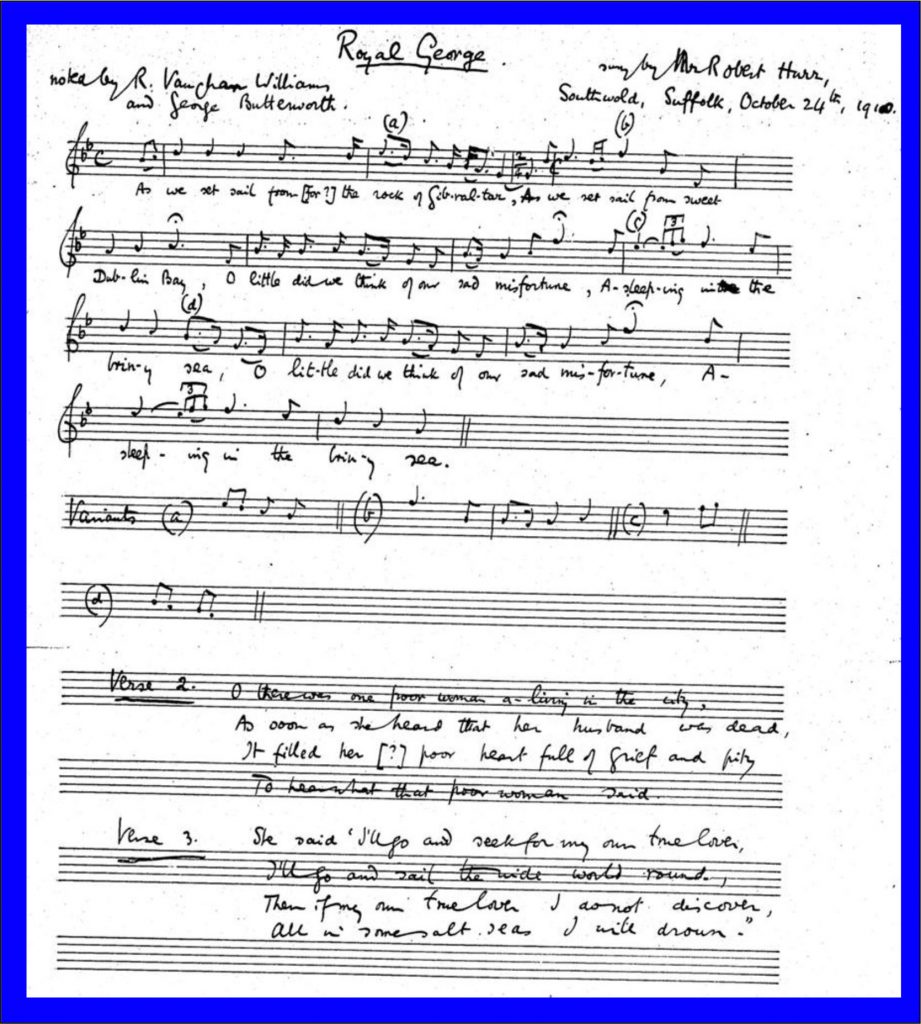
There has been speculation as to whether this song might relate to the Battle of Sole Bay which took place in 1672, but there’s little in the text to suggest that. Interestingly, there is actually a song about the Battle of Sole Bay – the subject of another post on this blog, The Battle of Sole Bay: an Unsung Song.
As well as being a singer, Robert played the concertina. The only tune noted from him is named The Liverpool Hornpipe in Vaughan Williams’ manuscript, although in fact it is nothing like the usual tune of that name, and is actually a variant of what is probably the most widely-known hornpipe of all, Soldier’s Joy. In Suffolk, hornpipes were, and still are, commonly used for ‘stepping’: an informal, improvised form of tap dancing, so it’s very likely that Robert would have played for such dancing in the pubs of Southwold.
George Hurr 1852-1928
George came between William and Robert in age. In 1875 he married Charlotte Jane Jarvis Pack and they soon started a family and set up in business running boarding house on East Cliff to cater for holiday makers from London in the season, whilst George continued to work as a fisherman.
Proof that the brothers worked together comes from the 1881 census, where George is found on board the Nancy Hugh in Lowestoft Harbour. With him are brothers William and Samuel. William, the eldest, is listed first and has signed the census form. The Nancy Hugh is described as a “dandy” in the business of long-line fishing, and the master is given as James Hurr (the oldest of the brothers), although he wasn’t on board on census night.
By 1901 George and his wife Charlotte were running a boarding house with holiday apartments in Stradbroke Road, which is where they were in 1910 when Vaughan Williams came to town.
We know that George sang from the memoirs of one of those summer visitors from London, Martin Shaw. His father, James Shaw was the organist at Hampstead Parish Church and brought his family here for the first time in the 1870s, when Martin was just a toddler. Martin spent a whole summer in Southwold recuperating from whooping cough when he was thirteen, and maintained a regular association with the town throughout his life, eventually retiring there in the 1940s. His abiding childhood memory of Southwold was of one George Hurr:
“George taught me to swim and to smoke. […] He used to take me out trawling all night. When the nets were down he would while away the time by singing very slowly an interminable ballad with the refrain – which I thought ill-timed – ‘And the salt water was his grave’.”
Neither I nor some of the most experienced song researchers in the country have yet been able to identify this song, but we can certainly identify with Martin Shaw’s sentiments!
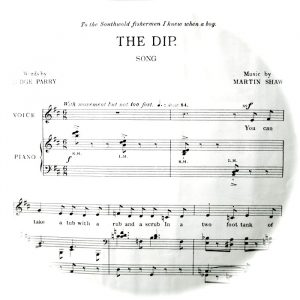 Martin Shaw grew up to be a very well-known and respected composer (Morning has Broken for example) and as a student he met Ralph Vaughan Williams. The two became lifelong friends and their correspondence includes some mention of folksong: Vaughan Williams encouraged Shaw to visit William Hurr but there’s no indication of whether he ever did – he certainly did not note down or describe any traditional singing apart from this one mention of George Hurr from his childhood years.
Martin Shaw grew up to be a very well-known and respected composer (Morning has Broken for example) and as a student he met Ralph Vaughan Williams. The two became lifelong friends and their correspondence includes some mention of folksong: Vaughan Williams encouraged Shaw to visit William Hurr but there’s no indication of whether he ever did – he certainly did not note down or describe any traditional singing apart from this one mention of George Hurr from his childhood years.
He did however dedicate a song he composed in 1924 “To the Southwold fishermen I knew when a boy”.
Details of the folksong collecting trip in 1910 by Ralph Vaughan Williams and George Butterworth, as well as full details of all the songs sung by the Hurrs, and other singers found on that trip, can be found on my other website https://katiehowson.co.uk/southwold-singers-1910
The Hurrs’ songs, complete with reconstructed sets of words, were also included in a booklet Blyth Voices published in 2003 by the East Anglian Traditional Music Trust. The research in that booklet is now superseded by my later work published online, but if you’re interested in singing the songs, that’s the book you need! https://www.eatmt.org.uk/shop/
To find out more about the song about the Battle of Sole Bay, see The Battle of Sole Bay: an Unsung Song.
William Hurr senior’s story (including some ghost stories!) is told in A Life through Five Sovereigns.
More of the history of some of the artistic visitors is traced in a talk I gave in March 2021 called Up from the Sea – Sea Songs on the Suffolk Coast, which can be watched here – it lasts about 20 minutes.
Martin Shaw’s memoir Up to Now (1929) is the source for the quote about George Hurr, and the Martin Shaw website is the source for the image of his dedication on his song The Dip. The website also has other relevant information and a whole article about his life in Southwold.
Thanks to the late John “Wiggy” Goldsmith for the Ben Hurr portrait, Gary May for the photo of Robert and his son Walter, and the Southwold Museum for the photos of William Hurr. As with all matters Southwoldian, the Southwold Museum (and its past and present curators) has been of huge help and very much deserves our support.
Song images courtesy of the Vaughan Williams Memorial Library at the English Folk Dance & Song Society.
* Addendum, 28.9.21
I have just come across a really interesting online talk by Toni Neobard for the Stowmarket U3A, called Don’t Eat the Cabin Boy which tells of her discovery of the facts of the sinking of the London on 11th January 1866 through examining a family story about an ancestor from Winterton in Norfolk. The talk lasts about an hour.
Please note: Anyone wishing to cite this original research should credit it to Katie Howson and cite this website as the source. © Katie Howson, 2021.
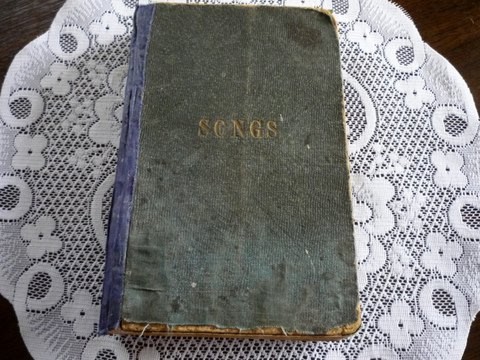
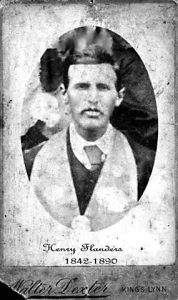
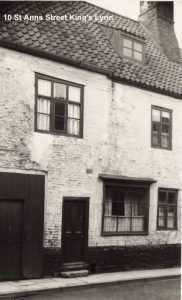 The newspapers of the time also detail some court cases about illegal fishing. Henry licensed mussel grounds (stone banks man-made for the purpose) in the Wash, and there are reports of other fishermen trying to fish these grounds, and of accusations of fishing in the closed season. The mussel beds were about seven miles from the fishing port in Lynn, and often necessitated a very early start in the morning and occasionally sleeping overnight on the boat. Henry owned various boats between 1873 and his death in 1890, including the Queen, Charles & William, Henry, Gainsboro Lass, Dove and Wave. These were, I think, fishing smacks, sailed by a crew of two or three men, catching mussels, whelks and shrimps according to the season. We can hear Henry’s own voice in an 1883 newspaper report:
The newspapers of the time also detail some court cases about illegal fishing. Henry licensed mussel grounds (stone banks man-made for the purpose) in the Wash, and there are reports of other fishermen trying to fish these grounds, and of accusations of fishing in the closed season. The mussel beds were about seven miles from the fishing port in Lynn, and often necessitated a very early start in the morning and occasionally sleeping overnight on the boat. Henry owned various boats between 1873 and his death in 1890, including the Queen, Charles & William, Henry, Gainsboro Lass, Dove and Wave. These were, I think, fishing smacks, sailed by a crew of two or three men, catching mussels, whelks and shrimps according to the season. We can hear Henry’s own voice in an 1883 newspaper report: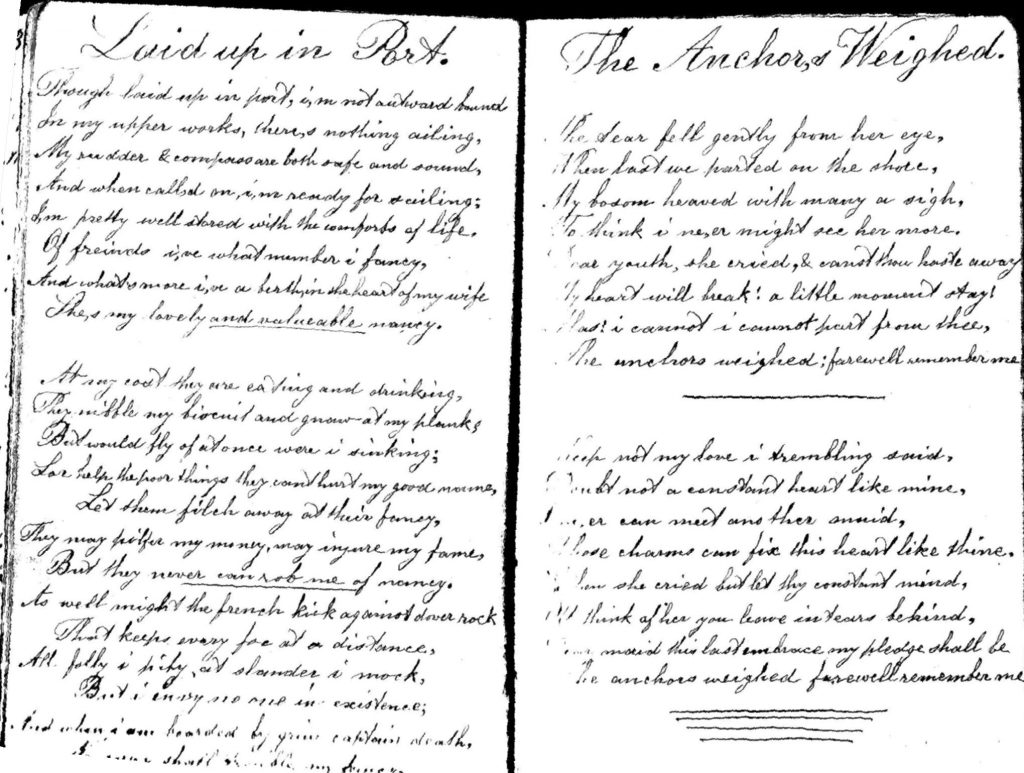
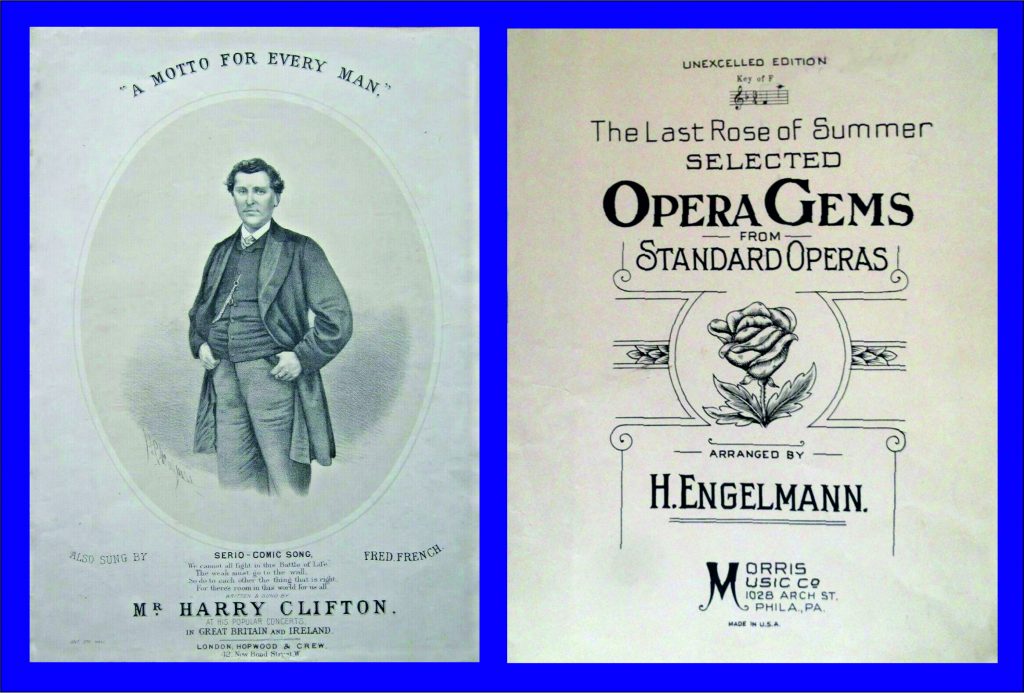
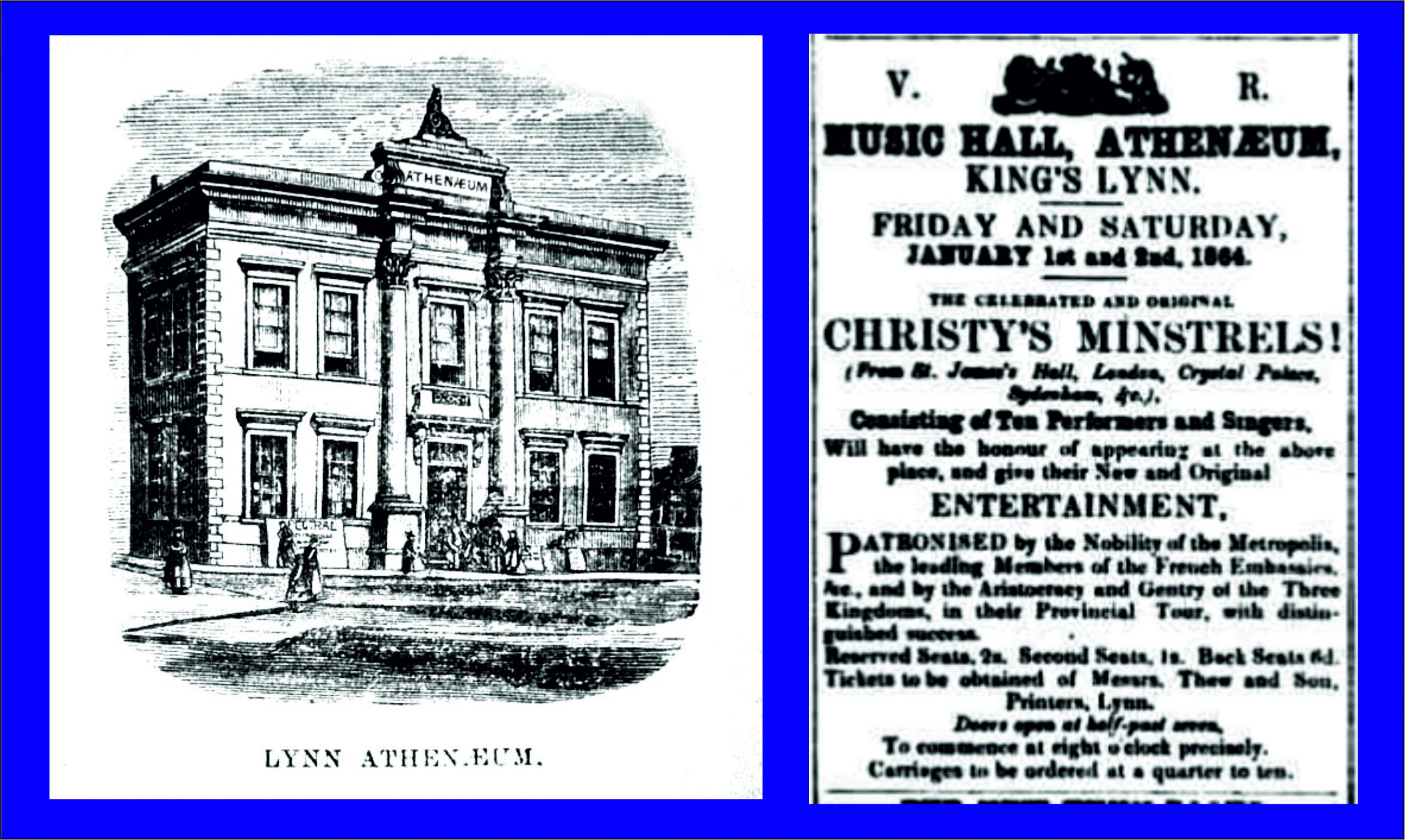
 There were certainly places in the North End itself where Flanders might have sung. The Dock Hotel stood on the corner of his street, and had its own “Music Hall” – the words still appear faintly on the wall in this modern photograph – and without walking more than a hundred yards, he would have had a choice of more than a dozen pubs.
There were certainly places in the North End itself where Flanders might have sung. The Dock Hotel stood on the corner of his street, and had its own “Music Hall” – the words still appear faintly on the wall in this modern photograph – and without walking more than a hundred yards, he would have had a choice of more than a dozen pubs.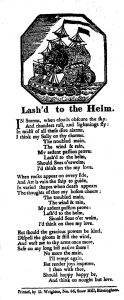 If Flanders actually knew how old his songs were, he might have suggested some of the oldest in his repertoire such as Black Ey’d Susan, Roast Beef of Old England or Tom Bowling but these would probably have been deemed too ‘commercial’ in style (as well as originating from known writers such as Charles Dibdin), and Vaughan Williams would probably have been more interested in others such as Lash’d to the Helm or Tars of the Blanch. These two sea songs seem to have been published only on broadsides – song sheets sold on the streets, with just the words, and no music attached.
If Flanders actually knew how old his songs were, he might have suggested some of the oldest in his repertoire such as Black Ey’d Susan, Roast Beef of Old England or Tom Bowling but these would probably have been deemed too ‘commercial’ in style (as well as originating from known writers such as Charles Dibdin), and Vaughan Williams would probably have been more interested in others such as Lash’d to the Helm or Tars of the Blanch. These two sea songs seem to have been published only on broadsides – song sheets sold on the streets, with just the words, and no music attached.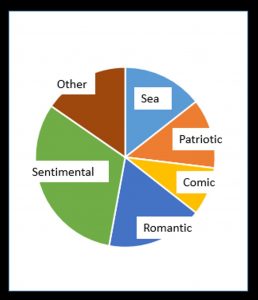
Recent Comments